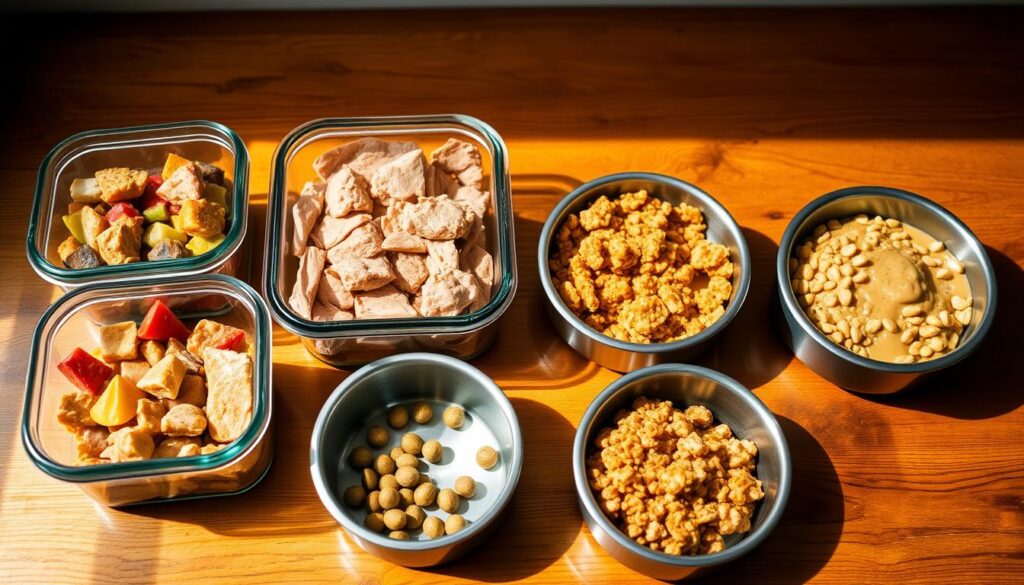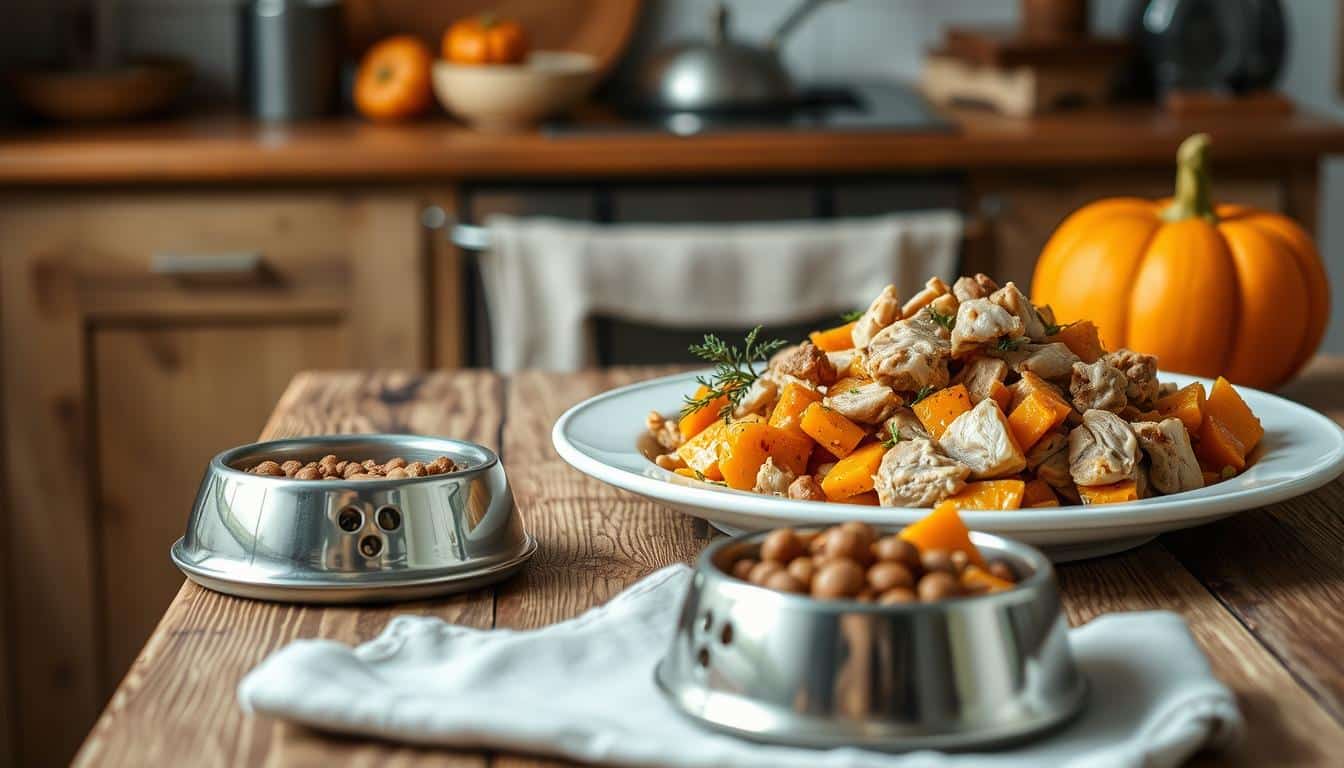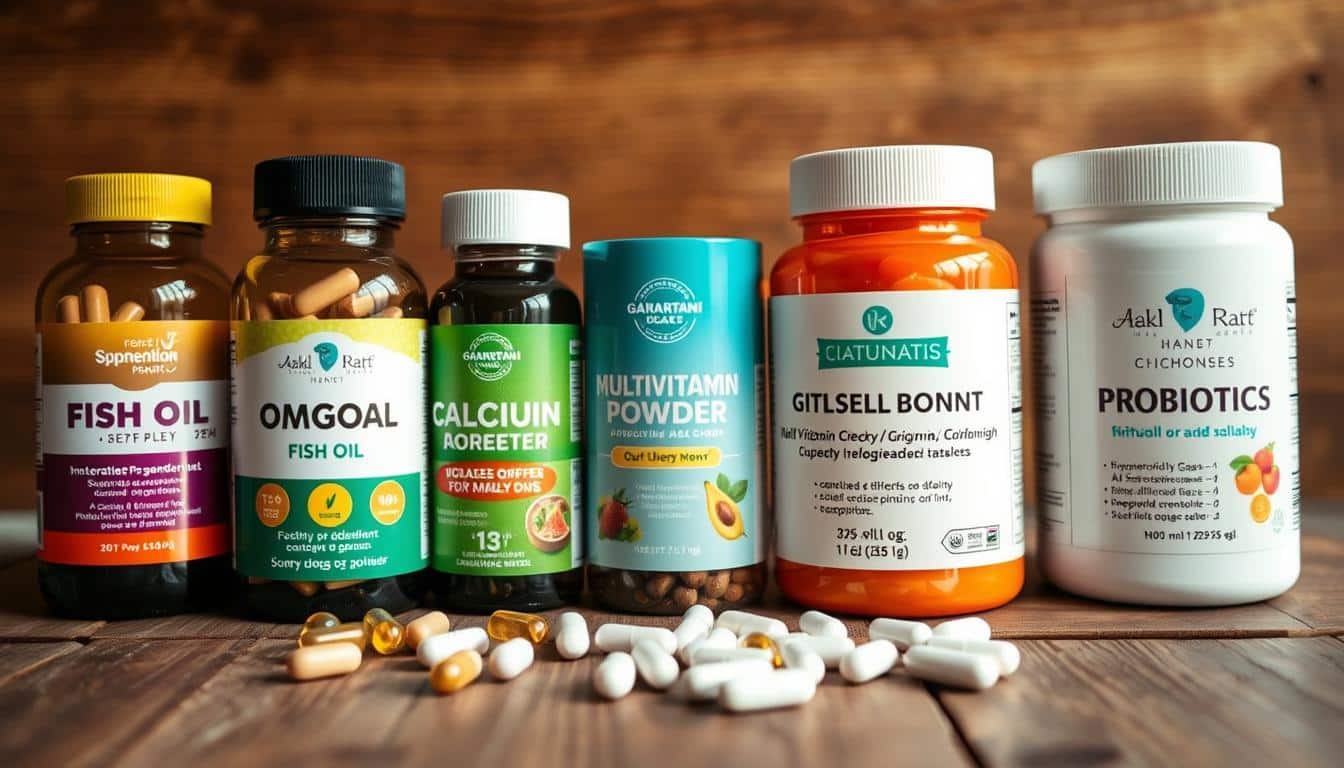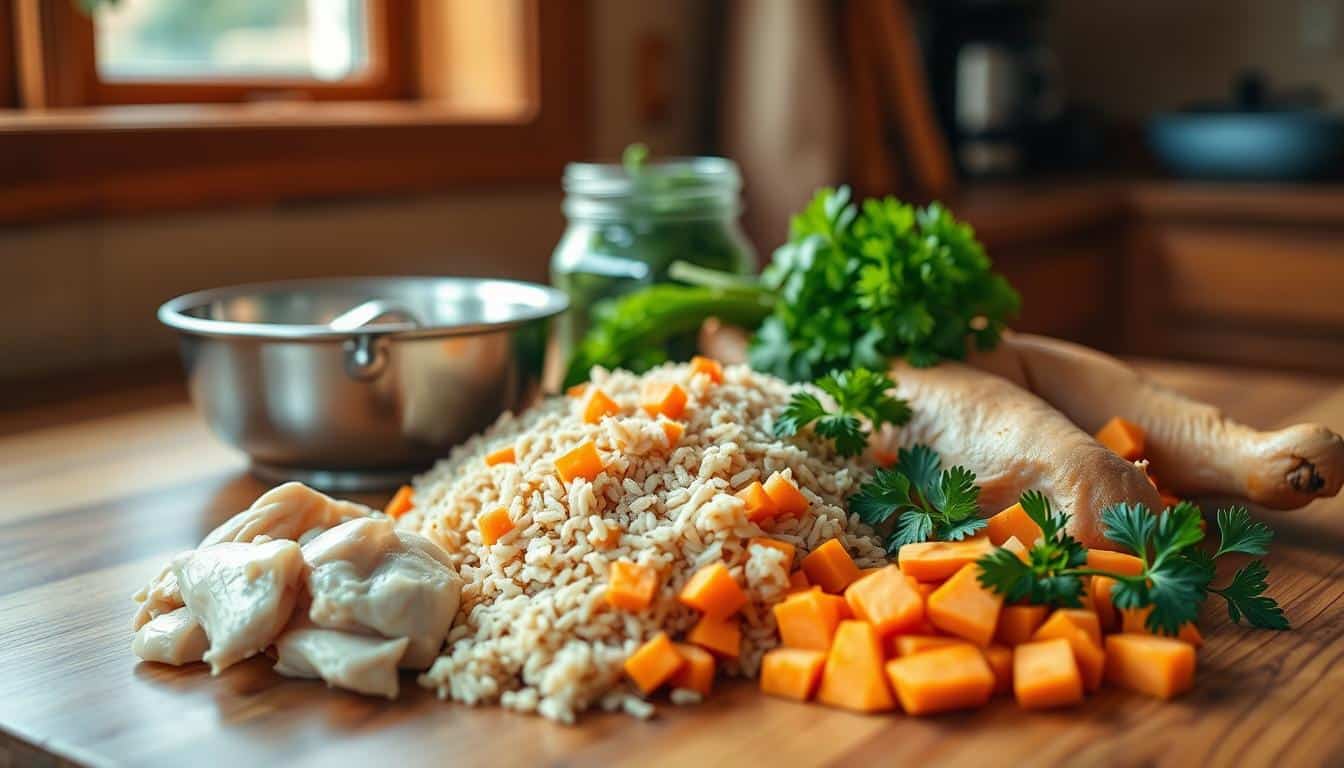This article gives clear tips on safely storing homemade dog food. Home-cooked meals can be healthier and tastier than store-bought food. However, they must be handled correctly to stay fresh.
Storing your dog’s food the right way stops bacteria from growing. It keeps the food’s nutrients and cuts down on waste. Our tips come from the ASPCA and FDA, as well as kitchen common sense.
We mainly talk about keeping food in the fridge or freezer. You’ll learn the best times to refrigerate or freeze dog food. We’ll also cover how to properly portion, label, and pick containers for freshness.
Here are some easy rules to follow: Keep refrigerated food at 32–39°F (0–4°C) for up to 5 days. For freezing, aim for 0°F (-18°C) or colder, which can last 3–6 months. It’s important to cool, portion, and serve the food correctly to keep it safe and healthy.
Importance of Proper Storage for Homemade Dog Food
Safe storage keeps homemade meals fresh and keeps pets safe from getting sick. It also means less waste, making feeding times easier for those with tight schedules. Doing small things differently at home helps food stay good and safe for pets to eat.
Why refrigeration and freezing matter for pet safety
Cooling food quickly stops bacteria that could make dogs sick. Putting food in the fridge right away and freezing meals for later are key tips from vets and food safety guides.
Storing food in the fridge and freezer the right way is important. It keeps food from staying warm too long and prevents sickness.
Risks of improper storage: bacteria, spoilage, and nutrient loss
Storing food poorly can lead to bacteria, mold, and bad smells. If dogs eat spoiled food, they could throw up, get diarrhea, or even face bigger health issues.
Keeping food too long or not cool enough can make it lose vitamins. Reheating it too much can also make the food less healthy.
How storage practices affect cost, waste, and feeding consistency
When food goes bad, owners have to throw it away and buy more. Freezing food in large batches can save time and money. But, it’s important to split it into portions and rotate stocks properly.
Staying organized can prevent running out of food unexpectedly. It leads to less waste, ensures pets are healthy, and makes feeding homemade food easier for everyone.
How to store homemade dog food safely
To keep your pets healthy and reduce waste, store homemade meals properly. Follow steps for cooling, refrigerating, and freezing. This ensures the food stays fresh and safe.
Immediate cooling: why you must let food reach room temperature before chilling
Let cooked food cool down to near room temp before refrigerating. Cooling dog food right away stops the fridge from getting warm. It also makes sure food cools down evenly.
Never leave cooked food out for more than two hours. In warm places or during summer, keep this time under one hour. This helps stop bacteria from growing.
Safe refrigerator temperatures and where to place containers
Keep your fridge set between 32–39°F (0–4°C). Always check this with a fridge thermometer.
Put containers in the fridge’s coldest spot, like the back or bottom shelf. Stay away from the door because opening it changes the temperature. Leave space around containers for air to move, keeping cooling steady.
Freezer temperature recommendations and long-term preservation
For storing food longer, keep your freezer at 0°F (-18°C) or lower. Quick freezing in the proper temperature preserves nutrients and texture.
Divide meals into single servings using containers or freezer bags. Press out extra air, seal well, and note the date. Place them in the freezer’s main section, not the door, for constant cold.
- Cool cooked food quickly but safely.
- Keep refrigerator temperature dog food consistent at 32–39°F.
- Freeze at 0°F or below and portion for easy thawing.
Refrigeration best practices for homemade dog food
Storing homemade meals fresh is easy with the right habits. It’s important to follow good fridge practices to keep the food’s nutrition and avoid making your pet sick. Before storing, make sure to use well-sealed containers and cool the food correctly.
Recommended fridge storage times (typical 3–5 days guideline)
Vets and pet food guides usually say to use homemade dog food within 3 to 5 days. It’s safest to use it within 3 days, especially if you’re unsure.
Throw away food if it has been sitting out for over two hours, or an hour in hot weather. It’s better to throw away food than to risk feeding your pet spoiled food.
How to arrange batches for coldest storage zones and airflow
Put sealed containers in the fridge’s coldest spots, like the back or bottom shelves. Make sure there’s space around items for air to move freely.
- Always put older batches in the front so you use them first.
- Don’t stack warm containers. Let them cool down before you seal them.
- Mark containers with dates to keep track of when you made them.
Signs food has gone bad in the refrigerator and when to discard
Be alert for clear signs that food has spoiled. Spoiled dog food can smell bad, have mold, feel slimy, or change color.
If you’re not sure, it’s better to throw it away. Keeping your pet healthy is the top priority.
Freezing strategies to extend shelf life and preserve nutrition
Freezing homemade dog food keeps meals safe for longer. Always set your freezer at 0°F (-18°C) or colder. This ensures the food stays high quality. Quick freezing prevents big ice crystals, which ruin texture and nutrition. Spread food thin on trays for this reason before you store it long-term.
Benefits of cold storage for homemade meals
Freezing makes food last longer and cuts down on waste. It lets you cook in big batches, saving time and money. It also keeps most vitamins and minerals intact. This means your dog gets all the nutrition they need.
Portioning for efficient freezer use
Dividing food into meal-sized portions makes your freezer work better. Use muffin tins or ice-cube trays for small servings. Then, store them in labeled bags or containers. This way, you defrost only what your dog will eat, reducing waste.
Recommended storage windows and rotation
Stick to the freezer’s suggested storage times for the best quality dog food. Try to use food within 3–6 months, aiming for 3–4 months for best taste and nutrition. Label each package with the freeze date and what’s inside. Always use the oldest food first to keep things fresh.
- Freeze at 0°F (-18°C) or below for best preservation.
- Store packages in the main compartment, away from the door for steady temperatures.
- Seal tightly to prevent freezer burn and nutrient loss while you preserve nutrition freezing dog food.
Choosing and maintaining storage containers for freshness
Picking the right container keeps meals safe and delicious. Choose food-grade, airtight options that suit your daily life. It’s important to match the container to its use: refrigeration, freezer, or daily meals.
Best container materials: BPA-free plastic, glass, and stainless steel
BPA-free containers are good for short-term fridge storage and carrying food. If freezing food, check that they are freezer-safe.
Glass is perfect for the fridge and doesn’t react with food. Mason jars and borosilicate containers prevent stains and odors.
Stainless steel is tough, good for serving and travelling. But, it’s not the best for freezing as it hides what’s inside and can dent.
Airtight sealing, vacuum removal of air, and preventing freezer burn
Airtight lids keep food fresh longer by cutting off oxygen. Use heavy-duty freezer bags or tight-seal containers for freezing.
To avoid freezer burn, remove as much air as you can. Wrap food in plastic, then foil, for extra safety.
Vacuum sealers make food last longer by cutting down oxidation. Store items compactly in the freezer’s coldest part to avoid temperature changes.
How to clean and sanitize containers safely between uses
Rinse containers immediately with hot water. Then, clean them with hot, soapy water or in the dishwasher on the highest safe setting.
- Sanitize with one tablespoon of household bleach per gallon of water; soak for one minute, then rinse well.
- Or, use a vinegar solution mixed 1:1 and soak for 30 minutes. After, rinse thoroughly.
Always let containers air dry before storing them. If containers crack, warp, or look worn, replace them to keep your pet safe and maintain quality.
Portioning, labeling, and organization for safe feeding
Good portioning, labels, and storage make homemade meals both safe and easy to serve. Set portion sizes using simple rules. Also, mark containers with important details. This way, everything is used before it goes bad.

How to determine portion sizes based on weight and feeding guidelines
Begin by feeding your dog about 2–3% of its body weight each day, in two meals or more. Adjust this amount based on factors like age, activity, and health. For specific needs, talk to a vet or nutrition expert.
Weigh cooked food with a kitchen scale for consistent feeds. Following expert tools ensures your dog’s diet is balanced.
Labeling essentials: date made, ingredients, portion size, and feeding notes
Label every container with the preparation and possible freezing date. Also, list all ingredients for safety and the exact portion size for easy meals. Note any special feeding instructions, like when to add supplements.
Using clear labels on dog food containers saves time and prevents mistakes. Waterproof labels and permanent markers work best, or use printed labels for legibility during storage.
First-in, first-out rotation and inventory systems for home kitchens
Use the FIFO method for dog food: put new batches behind older ones to ensure the oldest items are used first. This practice helps avoid waste and keeps food safe.
- Keep track of what you have on hand with a list on the freezer door or in a phone note.
- Organize containers by size and use to make serving quicker.
- Check and rotate your stock weekly and throw out anything past its prime.
Starting small with dog food organization can lead to a reliable system. Keeping consistent portions, clear labels, and a strict FIFO method ensures safe and easy feeding for both pets and owners.
Safe thawing, reheating, and serving procedures
Handling food safely after it’s been frozen is essential. It keeps homemade meals good to eat and healthy. Picking a thawing method that cuts down on bacteria and keeps nutrients is key. Small steps at this point can greatly benefit your dog’s health and how much they enjoy their meal.
Thawing options: fridge versus microwave
The best way to thaw dog food is in the fridge. You should move meal portions from the freezer to the fridge 24–48 hours before you need them. The size of the portion matters. Keeping food in the fridge while thawing keeps it at safe temperatures. This also slows down any bacterial growth.
Thawing food in the microwave is quicker but requires more attention. Be sure to use the defrost setting. You should stop frequently to stir the food. This helps avoid overheated areas that can cook the food unevenly. If you choose the microwave, you must feed your dog right away. Also, never let the food sit out at room temperature.
How long thawed food stays safe and refreezing rules
Food thawed in the fridge should be used within 2–3 days. Throw away any food left out for more than two hours. In hot weather, toss it after an hour. You should never refreeze dog food once it’s completely thawed.
Refreezing dog food can increase bacteria and ruin both its texture and nutritional value. For the best safety and quality, mark packages with the date they were thawed. Also, planning your meals ahead can help avoid the need to refreeze.
Reheating and ideal serving temperature
Reheat dog food gently to get it to the right temperature. You should aim for the food to be lukewarm or at room temperature, as most dogs prefer. Reheating too fast or too much can destroy vitamins that are sensitive to heat. It can also make the food less appealing.
Always stir the food well after reheating. This makes sure the heat spreads evenly. Before serving, test the food temperature with the back of your hand to ensure it’s not too hot. If you’ve thawed the food in the microwave, it’s very important to mix well and check the temperature to avoid hot spots.
- Thaw in fridge: 24–48 hours for typical portions.
- If microwaving, stir and serve right away.
- Use thawed food within 2–3 days and never refreeze dog food.
- Serve lukewarm; avoid overcooking to protect nutrients.
Other storage considerations and avoiding common mistakes
Making your own dog food means keeping it safe and nutritious. Focus on what you put in, how you handle it, and how you carry it. These little steps at the beginning and during travel help keep your pet safe and cut down on throwing food away.
Ingredients to avoid or handle carefully
Some foods are very bad for dogs. They should never eat xylitol, chocolate, grapes and raisins, onions, garlic, macadamia nuts, or certain mushrooms. These can make dogs very sick, even in tiny amounts.
Be careful with other ingredients, too. Dairy, raw eggs, and organ meats go bad quickly. Make sure to cook them well and cool them fast if your recipe needs them. Always use trusted recipes to make sure your dog gets all the nutrients they need.
Travel and on-the-go storage solutions
For short trips, keep fresh food cold in insulated cooler bags with ice packs. Dividing food into single servings helps keep it fresh and makes feeding easier. Choose containers that you can throw away or clean well to avoid germs spreading.
For longer trips, use a sturdy cooler and more frozen packs. Check the temperature and replace the ice when necessary. Remember to label the food with the date and what’s inside. This helps keep things organized while you’re traveling.
When to consult a veterinarian or nutrition expert
Always talk to your vet or a dog nutrition expert before switching to homemade food. Different dogs, like puppies, older ones, or those that are pregnant or have health issues, need special food plans. Many vets suggest using tools like Balance IT and getting your recipes checked by a professional to make sure they’re balanced.
If your dog’s stomach seems upset, they act weird, or the food doesn’t seem right, call your vet right away. Getting advice quickly can stop your dog from getting the wrong nutrients and deal with any safety worries quickly.
- Keep a short cooking-to-chill window.
- Label and rotate batches for first-in, first-out use.
- Avoid toxic foods dogs and follow vet-approved recipes.
Conclusion
Keeping homemade dog food safe is pretty straightforward. Cook it well, then cool it quickly in one to two hours. Use tight, right-sized containers for storage. Keep it in the fridge at 32–39°F for up to 5 days, or freeze it at 0°F for up to 6 months. Don’t forget to label each with the date and serving size. This helps use the oldest ones first.
Here’s a summary on keeping the food safe: never let it thaw on the counter. Avoid refreezing what you’ve already thawed. Throw away any food that smells bad or looks moldy or slimy. Choose BPA-free plastic, glass, or stainless steel for storage. Squeeze out the air to stop freezer burn.
Dividing into portions before freezing means less thawing and refreezing. This keeps the nutrients better.
Some tips for your dog food in the fridge or freezer: save time and money while keeping your dog healthy. Use a system to track what you have, and organize it by date. Put it in the coldest part of the fridge. If your dog needs a special diet, talk to a vet or a nutrition expert. They can help you make sure the food storage matches the diet plan.
FAQ
What is the purpose of proper storage for homemade dog food?
Why do refrigeration and freezing matter for pet safety?
What are the risks of improper storage?
How quickly should cooked homemade dog food be cooled before refrigerating?
What refrigerator temperature should I maintain and where should I place containers?
How long can I keep homemade dog food in the refrigerator?
What freezer temperature and storage windows should I follow?
How should I portion food for the freezer to avoid waste?
What container materials are best for storing homemade dog food?
How can I prevent freezer burn and oxidation?
How should I clean and sanitize storage containers?
What signs indicate refrigerated or frozen food has gone bad?
How long is thawed homemade dog food safe to use?
What are safe thawing methods and their pros and cons?
How should I reheat and serve thawed homemade dog food?
What ingredients require special handling or should be avoided?
How should I label and organize homemade dog food batches?
How do I determine portion sizes for my dog?
What are practical tips for travel and on-the-go storage?
When should I consult a veterinarian or veterinary nutritionist about storage and recipes?
What is the safe-storage workflow I should follow?
Content created with the help of Artificial Intelligence.



